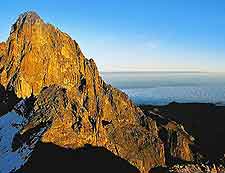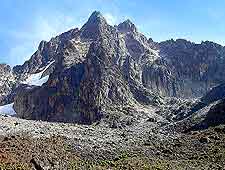Kenya History Facts and Timeline
(Kenya, KE, East Africa)

Famed for its scenic national parks and its wildlife-rich environment, Kenya is one of the most-visited tourist destinations in Africa. The country also hosts more than 40 separate peoples and cultures, meaning that the history of Kenya is a fascinating one. It dates back to the times of earliest hunter-gatherers, like the Khoisan, who were displaced by the technologically advanced Bantu by the 1st century BC.
Renowned conservationist and fossil-expert Richard Erskine Frere Leakey (born in Nairobi in 1944) is best remembered for his discovery of the 'Turkana boy'. This well-preserved skeleton helped to piece together our historical understanding of Homo Erectus (early 'upright man') and traces the pre-cursor of our current species back to this region some 1.6 million years ago. However, the modern history of Kenya begins in around the first century AD, when visiting Arab traders began to frequent the east coast.
The Swahili Coast
By the arrival of the 8th century, both Persian and Arab communities were commonplace along the eastern shoreline. Several centuries later and much of the Kenyan coast belonged to the Kilwa Sultanate, established by a Persian prince during the 10th century. The Arab empire continued to grow and it had established a huge port city, Mombasa, by the 16th century. The bustling port was notorious for its role in the slave and ivory trade.
Modern-day Mombasa is one of Kenya's biggest tourist destinations. Centred on the historic Fort Jesus, its Old Town is a popular place for shopping and dining. However, those who make the time to explore the very beautiful Fort Jesus itself will learn the shocking story of the country's role in the medieval slave trade, through its torture rooms and cells. At this time, nearly 90 percent of the population on Kenya's Swahili Coast were in fact used as slaves.
Another historic port on the Swahili Coast is Malindi. Dating back to the 14th century, the port was once compared to Mombasa. It is best-known for the Vasco da Gama Pillar, which marks the spot where this famous Portuguese explorer once landed.
Colonial Times in the Country
The colonial history of Kenya truly began in the year of 1885, when territory belonging to the Sultan of Zanzibar was handed to
Germany. The Germans passed on their coastal territories to the British in 1890, marking a period of construction and development. Interestingly, if you look at a map of the country, a kink in the borderline with Tanzania shows where Mount Kilimanjaro was gifted to the Kaiser as part of this deal.
When WWI broke out in 1914, the Germans and the British called a halt to hostilities in East Africa. However, they had not counted on the presence of a rogue German officer, Paul Emil von Lettow-Vorbeck, whose troops waged guerrilla warfare against the British in East Africa. These guerrillas were only driven out after the arrival of Indian soldiers from the subcontinent, commanded by the British.
After the turn of the century, increasing numbers of white settlers arrived in Kenya to grow tea and coffee, while the indigenous population's land rights became more and more restricted. Unsurprisingly, this oppression led to the Mau Mau rebellion.
October 1952 began a seven-year state of emergency, in which British and African troops were engaged in a campaign against the rebels. The 1954 capture of Mau Mau leader General China (Waruhiu Itote) was a turning point and led to the eventual removal of the Mau Mau from the capital, Nairobi. The Mau Mau military campaign eventually ended in 1956 and was followed by Kenya's first all-African elections in the year of 1957.

History of Independence
Kenya officially became an independent state in December 1963, when Jomo Kenyatta and the Kenya African National Union (often abbreviated as KANU) formed its first post-colonial government. Of note, the best place to learn about the country's road to independence is at the Nairobi National Museum, located in the Kenyan capital of Nairobi.
Jomo Kenyatta became the country's first president at the same time, but his early days in charge were marred by skirmishes with both
Ethiopia and Somalia. He died in 1978 and was replaced by Daniel Toroitich arap Moi. His single-party constitution came under plenty of fire, including an abortive coup attempt in 1982 and criticism of its undemocratic voting methods. Kenya's first 'free and fair' elections were judged to have taken place in 2003, when Moi was barred from taking part.
In 1998, the US embassy in Nairobi was destroyed in a terrorist attack, which caused the death of more than 200 people. Visitors to Nairobi can pay their respects to the victims of this tragedy at the memorial now standing on the site of the former embassy. A further violent period ensued from the 2007 elections, which were reckoned to be stolen by the incumbent politician Mwai Kibaki. The country had to be pulled back from the brink of civil war by a power-sharing deal where election victor Raila Odinga became Prime Minister.
 Famed for its scenic national parks and its wildlife-rich environment, Kenya is one of the most-visited tourist destinations in Africa. The country also hosts more than 40 separate peoples and cultures, meaning that the history of Kenya is a fascinating one. It dates back to the times of earliest hunter-gatherers, like the Khoisan, who were displaced by the technologically advanced Bantu by the 1st century BC.
Famed for its scenic national parks and its wildlife-rich environment, Kenya is one of the most-visited tourist destinations in Africa. The country also hosts more than 40 separate peoples and cultures, meaning that the history of Kenya is a fascinating one. It dates back to the times of earliest hunter-gatherers, like the Khoisan, who were displaced by the technologically advanced Bantu by the 1st century BC.